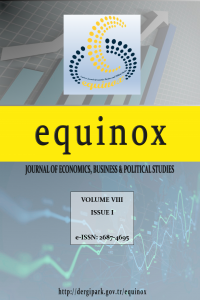Stratejik Bir Araç Olarak "Patent"
İşletmelerin varlıklarını sürdürebilmeleri ve ekonomik kȃrlılığı yakalayabilmelerinin altın anahtarı rekabet gücü olarak karşımıza çıkmaktadır. Öte yandan küresel rekabetin öneminin artması ile birlikte rekabete yön veren faktörlerin tespitine yönelik çalışmalar da çoğalmıştır. Yapılan çalışmaların vardığı ortak sonuç, 21. yüzyılda rekabet gücünü artıran en önemli faktörün yenilik yapma kabiliyeti olduğudur. Bu bakımdan bir yenilik göstergesi olan patent kavramının incelenmesi çok önemlidir. Genel anlamda patent, ilgili mallar üzerinde belirli bir süre için her türlü tasarrufu sahibine sağlayan dışlayıcı bir haktır. Patent, rekabette bilgi sağlama aracı, rakip ürünleri engelleme ve işletmenin hareket alanını genişletme imkanı sağlamaktadır. Böylece işletmeler rekabet avantajlarını kullanma imkanını da elde ederek, piyasada başarılı ve kalıcı olma fırsatı elde etmiş olurlar.
Anahtar Kelimeler:
Küreselleşme, Stratejik Yönetim, Rekabet, Sınai Mülkiyet Hakları, Patent
“Patent” As a Strategic Tool
Competitive power is the golden key for survival of businesses and to capture economic profitability. On the other hand, with increasing global competition the importance of studies aimed at identifying the factors that shape the competition increased. According to the consensus reached by recent studies, the most important factor in increasing the competitiveness in the 21st century is the ability to innovate. In this regard, examination of the concept of patents as an innovational indicator is very important. In general, a patent is an exclusive right that gives its owner the right to make use of their inventions for a limited period of time. A patent is a means of providing information in the competition; and it enables blocking of rival products and expanding business possibilities. Thus, businesses have the opportunity become permanent and successful in the market with the possibility of utilizing their competitive advantage.
___
- M Company Corporate (2002). A Century Of Innovation: The 3M Story. http://multimedia.3m.com/mws/mediawebserver mwsId=66666UF6EVsSyXTtlxMt4xT6EVtQEVs6EVs6E Vs6E666666--&fn=3M_COI_Book.pdf (17.07.2013)
- Aktan, C.C. (2008). Stratejik Yönetim ve Stratejik Planlama. Çimento İşveren Dergisi, Temmuz-Ağustos, 4‒21.
- Andrews, K.R. (1965). The Concept of Corporate Strategy. Illinois: Homewood.
- Bolt, J.F. (1989). Global Competitions: Some Criteria for Success. Business Horizons, 31 (1), 34‒41.
- Byars, L.L. (1992). Concepts of Strategic Management: Formulation and Implementation. Third Edition. New York: HarperCollins Publishers Inc.
- Cole, J. H. (2001). Patents and Copyrights: Do the Benefits Exceed the Costs? Journal of Libertaranian Studies, 15 (4), 79‒105.
- Daft, R.L. (1994). Management. Orlando: The Dryden Press.
- David, F.R. (1995). Strategic Management. Fifth Edition, New Jersey: Prentice Hall.
- Dinçer, Ö. (1998). Stratejik Yönetim ve İşletme Politikası. 5. Baskı, İstanbul: Beta Basım Yayın Dağıtım.
- Drucker, P.F. (1995). Gelecek İçin Yönetim. Ankara: İş Bankası Yayınları.
- Eren, E. (2002). Stratejik Yönetim ve İşletme Politikası. 6. Baskı. İstanbul: Beta Basım Yayın Dağıtım.
- Ernst, H. (2003). Patent Information for Strategic Technology Management.World Patent Information, 25, 233‒242.
- Feurer, R. ve K. Chaharbaghi (1995). Strategy Development: Past, Present and Future. Management Decision, 33 (6), 58‒70.
- Gökovalı, U. ve K. Bozkurt (2006). Fikri ve Sınai Mülkiyet Hakkı Olarak Patentler: Dünya ve Türkiye Açısından Tarihsel Bakış. Muğla Üniversitesi Sosyal Bilimler Dergisi, 16, 135‒146.
- Jordan, J. ve P. Jones (1997). Assessing Your Company’s Knowledge Management Style. Long Range Planning, 30 (3), 392‒398.
- Hamel, G. ve C.K. Prahalad (1990). The Core Competence of the Corporation. Harvard Business Review, 68 (3), 79‒91.
- Hofer, C.W. ve D. Schendel (1978). Strategy formulation: Analytical Concepts. St. Paul, MN: West Pub.
- Hill, C.W.L. ve G.R. Jones (2000). Strategic Management: An Integrated Approach. 6th Edition. Boston: Houghton Mifflin.
- Kırım, A. (1998). Yeni Dünyada Strateji ve Yönetim. İstanbul: Sistem Yayıncılık.
- Langinier, C. ve G. Moschini (2013). The Economics of Patents: An Overview. http:// ageconsearch.umn.edu/bitstream/18374/1/wp020293.pdf (10.06.2013).
- Lieberman, M.B. ve D. B. Montgomery (1988). First Mover Advantages: A Survey. Strategic Management Journal, 12, 41‒58.
- Porter, M.E. ve V.E. Millar (1985). How Information Gives You Competitive Advantage. Harward Business Review, 63 (4), 149-158.
- Rumelt, R.P. (1984). Towards a Strategic Theory of The Firm. (In Competitive Strategic Management, ed. R.B. Lamb). New Jersey: Prentice Hall.
- Sabah Gazetesi. (2008). Patent Ligindeki Tek Türk Arçelik. http://arsiv.sabah.com.tr/ 2008/03/05/haber,E2DFD8CE5EDE402F8F86E8099AF3A8FD.html (01.07.2013)
- Saruhan, Ş.C. ve T. Sulaoğlu (2001). Entelektüel Sermaye: Teori ve Uygulamadan Bir Örnek – Arçelik. 9. Ulusal Yönetim ve Organizasyon Kongresi, İstanbul Üniversitesi - İşletme
- Fakültesi 24-26 Mayıs 2001.
- Scherer, F.M. (1980). Industrial Market Structure and Economic Performances. Second Edition, Chicago: Rand-McNally.
- Thompson, J.L. (1997). Strategic Management: Awareness and Change. Third Edition, International Thompson Business Press.
- Tosun, K. (1978). İşletme Yönetimi, Birinci Cilt: Genel Esaslar. İstanbul: Fatih Matbaası.
- Yalçıner, U.G. (2000). Sınai Mülkiyetin İlkeleri. Ankara: Metal Ofset.
- Wartburg, I. ve T. Teichert, (2008). Valuing Patents and Licenses from a Business Strategy Perspective – Extending Valuation Cosniderations Using the Case of Nanotechnology. World Patent Information, 30, 106‒114.
- Yayın Aralığı: Yılda 2 Sayı
- Başlangıç: 2019
- Yayıncı: Siirt Üniversitesi
